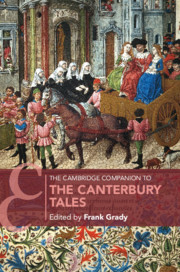Book contents
- The Cambridge Companion to The Canterbury Tales
- The Cambridge Companion to The Canterbury Tales
- Copyright page
- Contents
- Illustrations
- Contributors
- Preface
- Note on the Text
- Chronology
- Abbreviations
- 1 The Form of the Canterbury Tales
- 2 Manuscripts, Scribes, Circulation
- 3 The General Prologue
- 4 The Knight’s Tale and the Estrangements of Form
- 5 The Miller’s Tale and the Art of Solaas
- 6 The Man of Law’s Tale
- 7 The Wife of Bath’s Prologue and Tale
- 8 The Friar’s Tale and TheSummoner’s Tale in Word and Deed
- 9 Griselda and the Problem of the Human in The Clerk’s Tale
- 10 The Franklin’s Symptomatic Sursanure
- 11 The Pardoner and His Tale
- 12 The Prioress’s Tale
- 13 The Nun’s Priest’s Tale
- 14 Moral Chaucer
- 15 Chaucer’s Sense of an Ending
- 16 Postscript: How to Talk about Chaucer with Your Friends and Colleagues
- Further Reading
- Index
- Cambridge Companions to …
6 - The Man of Law’s Tale
Published online by Cambridge University Press: 21 August 2020
- The Cambridge Companion to The Canterbury Tales
- The Cambridge Companion to The Canterbury Tales
- Copyright page
- Contents
- Illustrations
- Contributors
- Preface
- Note on the Text
- Chronology
- Abbreviations
- 1 The Form of the Canterbury Tales
- 2 Manuscripts, Scribes, Circulation
- 3 The General Prologue
- 4 The Knight’s Tale and the Estrangements of Form
- 5 The Miller’s Tale and the Art of Solaas
- 6 The Man of Law’s Tale
- 7 The Wife of Bath’s Prologue and Tale
- 8 The Friar’s Tale and TheSummoner’s Tale in Word and Deed
- 9 Griselda and the Problem of the Human in The Clerk’s Tale
- 10 The Franklin’s Symptomatic Sursanure
- 11 The Pardoner and His Tale
- 12 The Prioress’s Tale
- 13 The Nun’s Priest’s Tale
- 14 Moral Chaucer
- 15 Chaucer’s Sense of an Ending
- 16 Postscript: How to Talk about Chaucer with Your Friends and Colleagues
- Further Reading
- Index
- Cambridge Companions to …
Summary
This chapter groups discussion of The Man of Law’s Tale into four broad topics. First is the intersecting representation of gender, race, and religious difference through which the tale complicates key questions about Christianity’s relationship to Islam, a relationship shaped as much by political and economic concerns as by theological ones. It thus opens equally complicated questions about the relationship between sacred and secular. Third is the tale’s preoccupation with the circulation of people and knowledge. Despite its generic similarity to saints’ Lives, the tale is perhaps less concerned with the truth of Christianity than with its transmission, with questions about the kind of knowledge stories produce, especially as they move across different discursive and territorial frames. The final section turns to narrative presentation and the teller’s status as a “Man of Law.” As an exploration of the impossibility of superimposing a stable system of meaning on a story about overlapping networks of mercantile, confessional, historical, and narrative practices, the tale has much to teach us about the layered, multipart narrative project of the Canterbury Tales itself.
Keywords
- Type
- Chapter
- Information
- The Cambridge Companion to The Canterbury Tales , pp. 89 - 104Publisher: Cambridge University PressPrint publication year: 2020

